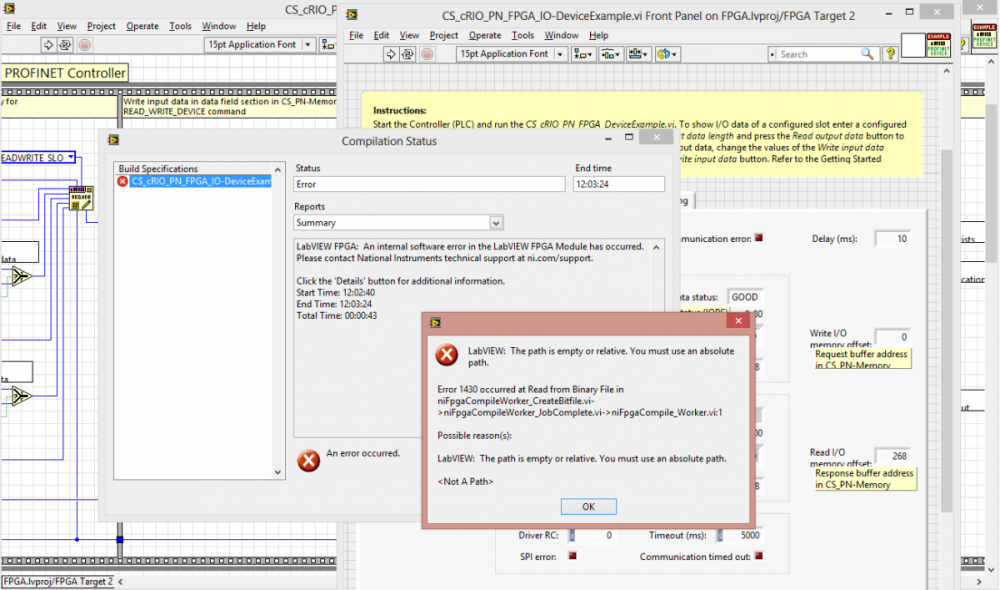Search the Community
Showing results for tags 'crio'.
-
Hi everyone, I will be presenting TS1360: "Implementing an Efficient Moving Average Filter in LabVIEW FPGA" on Thursday 1-2pm. Room 16B. These techniques are relevant for developing any sort of code on the FPGA, not necessarily filters. Many of the findings are a bit counter-intuitive for someone used to developing regular LabVIEW code or even Real-Time LabVIEW code. Hope to see some of you there or bump into you in the corridors of the Convention Centre! Cheers, Neville.
-
Just recently I bought the cRIO Profinet IO C - Series module, it came with a CD so first thing I did was install whatever necessary from the CD into my computer. Next thing I did was follow every single step provided from http://download.ni.com/support/softlib//embedded%20networks/NI-Industrial%20Communication/profinet/GettingStarted_cRIO_PN_IO-Device.pdf except for Step 3 where it ask me to import my GmBH file into the native software of my other controller (the example uses Siemen S7 HW config) which I want to communicate to because that other controller is still not available for me. Before the other controller becomes available, I need to make sure that this module is working as needed. However, at the fourth step I am stuck due the inability to compile the FPGA Example attached with the Comsoft installer CD that came along with the module. first I tried with the Ethernet RIO NI-9146, then I thought maybe the error was due to the absence of a controller. I switched to cRIO-9014 just to make sure, and the same error pops up. Any help would be greatly appreciated
-
Hello there! I'm currently working on the control of a machine that does a specific measurement while the sensor (composed of several strain gauges) slides along a sled. I would like to acquire the sensor Data and to relate it to the position of the sled. The machine also has simple User inputs as Buttons and simple outputs as LEDs. The motors are controlled by relais which are connected to DOs. I wanted to use the cRIO Wfm reference library for my project because it seems to be great at this task. My current problem is that whenever I try to start a measurement, I get the error message CompactRIO: (Hex 0xFE4C) You have entered a data rate that is not supported by the selected module and oversample clock frequency. As a matter of fact though, I know that the Delta sigma strain gauge modules support a sampling rate of 10.000S/s but I seem to get the error from the FPGA. I'll attach my FPGA VI and the Measure VI (which is normally located inside a statemachine) for your reference. - all of them written in LV2012. I also get the same error when Using the example VI provided in the RIO Wfm Library. Thank you for reading and eventually helping Untitled 1.vi Measurement.vi FPGA-Main.vi
-
Hello, everyone! I wanted to introduce the new MH-LCD-216, the very first cRIO display module. This is something that we know a lot of people have been asking for, so we are very excited to offer this new module to the LabVIEW community. We debuted the MH-LCD-216 at NI Week 2012 and the positive feedback was overwhelming. The website below has additional information and don't hesitate to give me a call or post here with any questions. MH-LCD-216 cRIO Display Module Happy compiling! Jpeg
- 5 replies
-
- labview rt
- fpga
-
(and 3 more)
Tagged with:
-
I'm using a cRIO with multiple NI modules and an S.E.A Gxxx 3G Module installed in Slot 1. For all NI modules I can programmatically read its corresponding serial number using a property node on the FPGA. However, this is not the case for the Gxxx 3G module, as no properties appear for this module. The frustrating thing is that in order to access this module from the real-time code, the module's serial number is required. For a single cRIO unit this would be acceptable, however I'll be deploying many many more than just a few and I really want to avoid manual inputs for obvious reasons. Can anyone please help me? Thanks.
-
All, I am new to cRIO, Scan Engine, and the current value table. I am trying to create a TAG configuration file and am adding all of my data acquisition channels. Each channel is of course part of the Scan Engine. I need help understanding what to put as the address for each CIE tag. I am using the NI provided tag configuration editor. When I click "Browse" and select my project, the list of options comes up empty. Any help would be appreciated. Thanks!
-
- crio
- tag configuration
-
(and 3 more)
Tagged with:
-
LV2011 RT, crio-9076, using NSV's to share data back to the PC and send commands to the rio. I'm getting very slow reads of the NSV's in the RIO (on the order of 250-350ms). The shared variable engine is hosted on the RIO. I've got a critical timed loop reading from FIFO's and writing to scan engine I/O variables and reading from scan engine I/O and writing to FIFO's. I have a non-time critical communication loop that reads from NSV's and writes to FIFO's and reads from FIFO's and writes to NSV's. The time-critical loop spins like a top, 1-2ms tops in reading/writing FIFO to/from I/O vars. The reading FIFO -> writing to NSV is slow (30-40ms), but not nearly as slow as reading from NSV and writing to FIFO. Things I have tried: Disconnected typedefs from all the NSV's - this was necessary to deploy a built executable to the RIO (and have it work, that is). Some new bug in LV2011 according to NI. Changed all typedefs to variants and recast them on the RIO - this sped things up by 1/3 or so. I split the work up in subVI's for analysis purposs and the casting and writing to FIFO is very fast, it's definitely the read operation that's being pokey. Current workaround: I'm using an Updated boolean to tell the RIO when to actually read the NSV's so that my average loop time doesn't suffer so much. This works, but I want to know the why's and wherefore's of this being so slow. Further details: Exactly what I'm reading: 15 element boolean array (this is very fast by itself and I'm reading it on every loop now, not just when updated is true with no problem) 4 "position command" clusters (currently cast to variant) Enum targetEnum controlModeEnum ChannelEnum PVDouble commandDouble man controlCluster Control_ParametersEnum PV_TypeCluster PID_gainsDouble KcDouble TiDouble TdCluster Setpoint_rangeDouble highDouble lowCluster output_rangeDouble highDouble low 1 "test command" cluster (currently cast to variant)Enum trigger channelEnum trigger directionDouble lowerLimitDouble upperLimitBoolean StartBoolean Stop Those enums are 16-bit, so we're talking about 2624 bits in the 4 control clusters + 162 in the test command + 15 in the boolean array = 2801 = 350 bytes. Call it 500? with some structure padding from the cluster organization. Why would it take 300+ms to read less than 1KB of data? Best regards, Mike
-
I was very excited to recently find the MySQL connectors for LabVIEW. There was a free/OS one posted on NI, and there was a pay for proffesionally supported one from Safir over in France. (www.safir.fr) I think a Lava member developed the free one. After I got the PO together for the Safir version, my boss tells me we may be switching to PostgreSQL, and BAM, I am back to square one. Why does it matter? Because our code base is supposed to run the same on Windows, Linux and cRIO depending and need and circumstance. Now there is a Sourceforge project for LabVIEW and PostgreSQL, but it relies on DLLs. I suppose I could do something weird like write a wrapper in LabWindows CVI and talk to that via LabVIEW? Or I could read the prorocol chapter in the postgreSQL manual and do it from scratch in LabVIEW?
-
Hello. I am trying to connect some Beckhoff EtherCAT modules to a cRIO and at the beginning everything was looking good, but now I have some serious troubles with the EtherCAT drivers. When I am trying to start or deploy a project everything is crashing, cRIO is rebooting, PC to cRIO communication is lost and nothing is working. The problem is with the EtherCAT drivers, because if the EtherCAT drivers are disabled everything is working. Does anybody has any idea what should I try? Did somebody managed to use Beckhoff EtherCAT modules with a cRIO and LabVIEW 2009? Any help or reply is much appreciated. Kind regards, Greg








